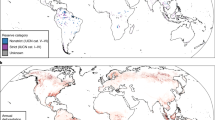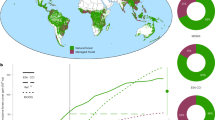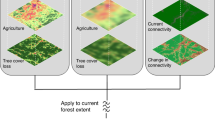Abstract
Tropical forests vary in composition, structure and function such that not all forests have similar ecological value. This variability is caused by natural and anthropogenic disturbance regimes, which influence the ability of forests to support biodiversity, store carbon, mediate water yield and facilitate human well-being. While international environmental agreements mandate protecting and restoring forests, only forest extent is typically considered, while forest quality is ignored. Consequently, the locations and loss rates of forests of high ecological value are unknown and coordinated strategies for conserving these forests remain undeveloped. Here, we map locations high in forest structural integrity as a measure of ecological quality on the basis of recently developed fine-resolution maps of three-dimensional forest structure, integrated with human pressure across the global moist tropics. Our analyses reveal that tall forests with closed canopies and low human pressure typical of natural conditions comprise half of the global humid or moist tropical forest estate, largely limited to the Amazon and Congo basins. Most of these forests have no formal protection and, given recent rates of loss, are at substantial risk. With the rapid disappearance of these ‘best of the last’ forests at stake, we provide a policy-driven framework for their conservation and restoration, and recommend locations to maintain protections, add new protections, mitigate deleterious human impacts and restore forest structure.
This is a preview of subscription content, access via your institution
Access options
Access Nature and 54 other Nature Portfolio journals
Get Nature+, our best-value online-access subscription
$29.99 / 30 days
cancel any time
Subscribe to this journal
Receive 12 digital issues and online access to articles
$119.00 per year
only $9.92 per issue
Buy this article
- Purchase on Springer Link
- Instant access to full article PDF
Prices may be subject to local taxes which are calculated during checkout




Similar content being viewed by others
Data availability
Full details of the forest structural condition and forest structural integrity maps are available in ref. 22. Input and output datasets can be accessed via FigShare: https://figshare.com/account/home#/projects/72164.
Code availability
The Google Earth Engine code is available at: https://code.earthengine.google.com/625bede18e265d81f6184b27129fecf8.
References
Turubanova, S., Potapov, P. V., Tyukavina, A. & Hansen, M. C. Ongoing primary forest loss in Brazil, Democratic Republic of the Congo, and Indonesia. Environ. Res. Lett. 13, 074028 (2018).
Watson, J. E. M. et al. The exceptional value of intact forest ecosystems. Nat. Ecol. Evol. 2, 599–610 (2018).
COP 11 Decision X/2. Strategic Plan for Biodiversity 2011–2020 (Convention on Biological Diversity, 2010).
Transforming Our World: The 2030 Agenda For Sustainable Development A/RES/70/1 Resolution adopted by the United Nations General Assembly (United Nations, 2015).
Adoption of the Paris Agreement. Proposal by the President Draft Decision -/CP.21 (UNFCCC, 2015).
Parks Canada Guide to Management Planning (Parks Canada Agency, 2008).
Parrish, J. D., Braun, D. P. & Unnasch, R. S. Are we conserving what we say we are? Measuring ecological integrity within protected areas. BioScience 53, 851–860 (2003).
Anderson, J. E. A conceptual framework for evaluating and quantifying naturalness. Conserv. Biol. 5, 347–352 (1991).
Tierney, G. L., Faber-Langendoen, D., Mitchell, B. R., Shriver, W. G. & Gibbs, J. P. Monitoring and evaluating the ecological integrity of forest ecosystems. Front. Ecol. Environ. 7, 308–316 (2009).
Kricher, J. Tropical Ecology (Princeton Univ. Press, 2011).
Lindenmayer, D. B. & Franklin, J. F. Conserving Forest Biodiversity: A Comprehensive Multiscaled Approach (Island Press, 2002).
Rozendaal, D. M. A. et al. Biodiversity recovery of neotropical secondary forests. Sci. Adv. 5, eaau3114 (2019).
Cortés-Gómez, A. M., Castro-Herrera, F. & Urbina-Cardona, J. N. Small changes in vegetation structure create great changes in amphibian ensembles in the Colombian Pacific rainforest. Trop. Conserv. Sci. 6, 749–769 (2013).
Gibson, L. et al. Primary forests are irreplaceable for sustaining tropical biodiversity. Nature 478, 378–381 (2011).
Poorter, L. et al. Diversity enhances carbon storage in tropical forests. Glob. Ecol. Biogeogr. 24, 1314–1328 (2015).
Running, S. W. et al. A continuous satellite-derived measure of global terrestrial primary production. BioScience 54, 547–560 (2004).
Bonan, G. B. & Doney, S. C. Climate, ecosystems, and planetary futures: the challenge to predict life in Earth system models. Science 359, eaam8328 (2018).
Symes, W. S., Edwards, D. P., Miettinen, J., Rheindt, F. E. & Carrasco, L. R. Combined impacts of deforestation and wildlife trade on tropical biodiversity are severely underestimated. Nat. Commun. 9, 4052 (2018).
Lindenmayer, D. B., Laurance, W. F. & Franklin, J. F. Global decline in large old trees. Science 338, 1305–1306 (2012).
Pfeifer, M. et al. Creation of forest edges has a global impact on forest vertebrates. Nature 551, 187–191 (2017).
Barlow, J. et al. Anthropogenic disturbance in tropical forests can double biodiversity loss from deforestation. Nature 535, 144–147 (2016).
Hansen, A. et al. Global humid tropics forest structural condition and forest structural integrity maps. Sci. Data 6, 232 (2019).
Dinerstein, E. et al. An ecoregion-based approach to protecting half the terrestrial realm. BioScience 67, 534–545 (2017).
Hansen, M. C. et al. High-resolution global maps of 21st-century forest cover change. Science 342, 850–853 (2013).
Venter, O. et al. Sixteen years of change in the global terrestrial human footprint and implications for biodiversity conservation. Nat. Commun. 7, 12558 (2016).
The World Database on Protected Areas (WDPA) (IUCN and UNEP-WCMC, 2019).
Di Marco, M., Venter, O., Possingham, H. P. & Watson, J. E. M. Changes in human footprint drive changes in species extinction risk. Nat. Commun. 9, 4621 (2018).
Armenteras, D., Espelta, J. M., Rodríguez, N. & Retana, J. Deforestation dynamics and drivers in different forest types in Latin America: three decades of studies (1980–2010). Glob. Environ. Change 46, 139–147 (2017).
Lenton, T. M. et al. Climate tipping points—too risky to bet against. Nature 575, 592–595 (2019).
Lovejoy, T. E. & Nobre, C. Amazon tipping point. Sci. Adv. 4, eaat2340 (2018).
Laurance, W. F. et al. A global strategy for road building. Nature 513, 229–232 (2014).
Jones, K. R. et al. One-third of global protected land is under intense human pressure. Science 360, 788–791 (2018).
Golden Kroner, R. E. et al. The uncertain future of protected lands and waters. Science 364, 881–886 (2019).
Geldmann, J., Manica, A., Burgess, N. D., Coad, L. & Balmford, A. A global-level assessment of the effectiveness of protected areas at resisting anthropogenic pressures. Proc. Natl. Acad. Sci. USA 116, 23209–23215 (2019).
DeFries, R., Karanth, K. K. & Pareeth, S. Interactions between protected areas and their surroundings in human-dominated tropical landscapes. Biol. Conserv. 143, 2870–2880 (2010).
Polak, T. et al. Efficient expansion of global protected areas requires simultaneous planning for species and ecosystems. R. Soc. Open Sci. 2, 150107 (2015).
Garnett, S. T. et al. A spatial overview of the global importance of indigenous lands for conservation. Nat. Sustain. 1, 369–374 (2018).
Jonas, H. D., Barbuto, V., Jonas, H. C., Kothari, A. & Nelson, F. New steps of change: looking beyond protected areas to consider other effective area-based conservation measures. Parks 20, 111–127 (2014).
Brancalion, P. H. S. et al. Global restoration opportunities in tropical rainforest landscapes. Sci. Adv. 5, eaav3223 (2019).
Chazdon, R. L. et al. Rates of change in tree communities of secondary neotropical forests following major disturbances. Philos. Trans. R. Soc. Lond. B 362, 273–289 (2007).
Chazdon, R. L. Beyond deforestation: restoring forests and ecosystem services on degraded lands. Science 320, 1458–1460 (2008).
Venter, O. et al. Harnessing carbon payments to protect biodiversity. Science 326, 1368–1369 (2009).
Margules, C. R. & Pressey, R. L. Systematic conservation planning. Nature 405, 243–253 (2000).
Griscom, B. W. et al. National mitigation potential from natural climate solutions in the tropics. Philos. Trans. R. Soc. B 375, 20190126 (2020).
Pereira, H. M. et al. Essential biodiversity variables. Science 339, 277–278 (2013).
Olson, D. M. & Dinerstein, E. The Global 200: priority ecoregions for global conservation. Ann. Missouri Bot. Gard. 89, 199–224 (2002).
Pan, Y. et al. A large and persistent carbon sink in the world’s forests. Science 333, 988–993 (2011).
Prevedello, J. A., Winck, G. R., Weber, M. M., Nichols, E. & Sinervo, B. Impacts of forestation and deforestation on local temperature across the globe. PLoS ONE 14, e0213368 (2019).
Gorelick, N. et al. Google Earth Engine: planetary-scale geospatial analysis for everyone. Remote Sens. Environ. 202, 18–27 (2017).
Šavrič, B., Patterson, T. & Jenny, B. The Equal Earth map projection. Int. J. Geogr. Inf. Sci. 33, 454–465 (2019).
Tyukavina, A. et al. Aboveground carbon loss in natural and managed tropical forests from 2000 to 2012. Environ. Res. Lett. 10, 074002 (2015).
Goetz, S. & Dubayah, R. Advances in remote sensing technology and implications for measuring and monitoring forest carbon stocks and change. Carbon Manag. 2, 231–244 (2011).
Hansen, A. J., Phillips, L. B., Dubayah, R., Goetz, S. & Hofton, M. Regional-scale application of lidar: variation in forest canopy structure across the southeastern US. For. Ecol. Manag. 329, 214–226 (2014).
Venter, O. et al. Global terrestrial Human Footprint maps for 1993 and 2009. Sci. Data 3, 160067 (2016).
Sanderson, E. W. et al. The human footprint and the last of the wild. BioScience 52, 891–904 (2002).
Tucker, M. A. et al. Moving in the Anthropocene: global reductions in terrestrial mammalian movements. Science 359, 466–469 (2018).
Dudley, N. (ed.) Guidelines for Applying Protected Area Management Categories (IUCN, 2008).
Dubayah, R. et al. The Global Ecosystem Dynamics Investigation: high-resolution laser ranging of the Earth’s forests and topography. Sci. Remote Sens. 1, 100002 (2020).
Acknowledgements
The work was funded by the NASA Biodiversity and Ecological Forecasting Program under the 2016 ECO4CAST solicitation through grant no. NNX17AG51G, the NASA Global Ecosystem Dynamics Investigation grant no. NNL15AA03 to S.J.G. and the NASA GEO solicitation grant no. 80NSSC18K0338 to P.J.
Author information
Authors and Affiliations
Contributions
A.J.H., J.E., S.J.G., M.H., O.V. and J.E.M.W. conceived the study. A.J.H., P.B., K.B. and S.A. analysed the data. P.B. designed the graphics. J.E., A.L.S.V. and C.S. developed policy implications. S.R.-B. and D.A. supported field reconnaissance. A.J.H. wrote the manuscript with critical inputs from P.B., J.E., S.J.G., M.H., O.V., J.E.M.W., P.A.J., A.L.S.V., K.B., R.P., S.A., C.S., S.R.-B. and D.A.
Corresponding author
Ethics declarations
Competing interests
The authors declare no competing interests.
Additional information
Peer review information Peer reviewer reports are available.
Publisher’s note Springer Nature remains neutral with regard to jurisdictional claims in published maps and institutional affiliations.
Supplementary information
Supplementary Information
Supplementary Fig. 1. Map of the tropical and subtropical moist broadleaf forests.
Supplementary Tables
Supplementary Tables 1–5.
Rights and permissions
About this article
Cite this article
Hansen, A.J., Burns, P., Ervin, J. et al. A policy-driven framework for conserving the best of Earth’s remaining moist tropical forests. Nat Ecol Evol 4, 1377–1384 (2020). https://doi.org/10.1038/s41559-020-1274-7
Received:
Accepted:
Published:
Issue Date:
DOI: https://doi.org/10.1038/s41559-020-1274-7
This article is cited by
-
Human footprint is associated with shifts in the assemblages of major vector-borne diseases
Nature Sustainability (2023)
-
Nation-wide mapping of tree-level aboveground carbon stocks in Rwanda
Nature Climate Change (2023)
-
Extending the conservation impact of great ape research: Flagship species sites facilitate biodiversity assessments and land preservation
Primates (2023)
-
Landscape-scale benefits of protected areas for tropical biodiversity
Nature (2023)
-
Humid tropical vertebrates are at lower risk of extinction and population decline in forests with higher structural integrity
Nature Ecology & Evolution (2022)



